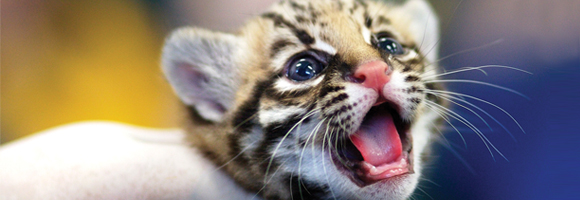Our Last Baby of 2012! An Endangered Brazilian Ocelot Kitten
CINCINNATI – (January 10, 2013) The Cincinnati Zoo & Botanical Garden’s Lindner Center for Conservation & Research of Endangered Wildlife (CREW) is excited to announce the Zoo’s last birth of 2012 – an endangered Brazilian ocelot kitten. The kitten was born on December 31, 2012 following an artificial insemination (AI) with freshly-collected semen from the Zoo’s resident male ocelot, “Monsieur.”
 The mother, “Sala” was inseminated in both oviducts using a new laparoscopic approach developed by scientists from CREW. Pregnancy was diagnosed at 60 days post-AI and the female gave birth naturally to a single kitten 23 days later. This birth represents the fifth pregnancy worldwide in ocelots resulting from AI and only the second produced by CREW scientists using this new laparoscopic oviductal AI method.
The mother, “Sala” was inseminated in both oviducts using a new laparoscopic approach developed by scientists from CREW. Pregnancy was diagnosed at 60 days post-AI and the female gave birth naturally to a single kitten 23 days later. This birth represents the fifth pregnancy worldwide in ocelots resulting from AI and only the second produced by CREW scientists using this new laparoscopic oviductal AI method.
Both Sala and the kitten are currently being housed in a quiet off-exhibit location but likely will be transferred to the ocelot exhibit in the Zoo’s Night Hunters building later this spring for public viewing.
Sala, an 8-year old, first-time mother, is the offspring of a founder pair imported to the US from Brazil in 1999. The 14 year old, first-time father, Monsieur, is the offspring of another Brazilian founder pair imported to Canada in 1997. At the recommendation of the Ocelot Species Survival Plan (SSP), the male was transferred from the Granby Zoo to the Cincinnati Zoo in 2008 for pairing but behavioral incompatibilities prevented the cats from breeding naturally.
Brazilian ocelots have been on the endangered species list for more than 25 years. The American Zoo and Aquarium Association (AZA) established its first Species Survival Plans (SSP) for small-field cats, including the ocelot, in 2001. Small sized cats, including the ocelot, have been severely neglected in both scientific and conservation circles, with little information on their natural history or conservation status in the wild. Population projections indicate that several small cat species, including the ocelot, will see their genetic diversity reduced to dangerously low levels in the next 50 years.
Reproductive sciences are playing a key role in helping to address the conservation and management challenges associated with maintaining these small cat SSP species. Reproductive sciences include multiple research disciplines including electroejaculation, artificial insemination (AI), in vitro fertilization (IVF), embryo transfer (ET), sperm and embryo cryopreservation, among others.

